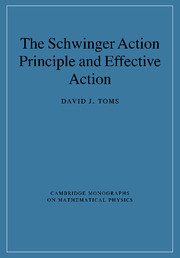Book contents
- Frontmatter
- Contents
- Preface
- 1 Action principle in classical mechanics
- 2 Action principle in classical field theory
- 3 Action principle in quantum theory
- 4 The effective action
- 5 Quantum statistical mechanics
- 6 Effective action at finite temperature
- 7 Further applications of the Schwinger action principle
- 8 General definition of the effective action
- Appendix 1 Mathematical appendices
- Appendix 2 Review of special relativity
- Appendix 3 Interaction picture
- Bibliography
- Index
2 - Action principle in classical field theory
Published online by Cambridge University Press: 27 October 2009
- Frontmatter
- Contents
- Preface
- 1 Action principle in classical mechanics
- 2 Action principle in classical field theory
- 3 Action principle in quantum theory
- 4 The effective action
- 5 Quantum statistical mechanics
- 6 Effective action at finite temperature
- 7 Further applications of the Schwinger action principle
- 8 General definition of the effective action
- Appendix 1 Mathematical appendices
- Appendix 2 Review of special relativity
- Appendix 3 Interaction picture
- Bibliography
- Index
Summary
Continuous systems
So far we have been concerned with a single point particle moving in some potential. The extension to a system of point particles is fairly obvious since for non-interacting particles the energy is additive. This means that in the absence of interactions the total Lagrangian, or Hamiltonian, is obtained simply by summing over the individual Lagrangians or Hamiltonians. If Li is the Lagrangian for the ith particle on its own, then L = Σi Li with a similar result for the Hamiltonian. In classical field theory we are concerned with a continuous distribution of mass and energy. For example, the electromagnetic field of a point charge (the Coulomb field) extends over all space. We can describe such a system using a Lagrangian or Hamiltonian framework. To begin with, our initial model will be a one-dimensional vibrating string.
Consider a string of total length ℓ with ends fixed at x = 0 and x = ℓ. Assume that the string undergoes a small displacement from equilibrium in such a way that the tension in the string remains constant. Focus attention on a small element of string of length ds at a given time t. By taking ds arbitrarily small, the small segment of string can be considered as a straight line segment. Let ψ(x, t) and ψ(x + dx, t) be the displacements of the two ends of the segment at the given time t. The situation is pictured in Fig. 2.1.
- Type
- Chapter
- Information
- The Schwinger Action Principle and Effective Action , pp. 40 - 99Publisher: Cambridge University PressPrint publication year: 2007



